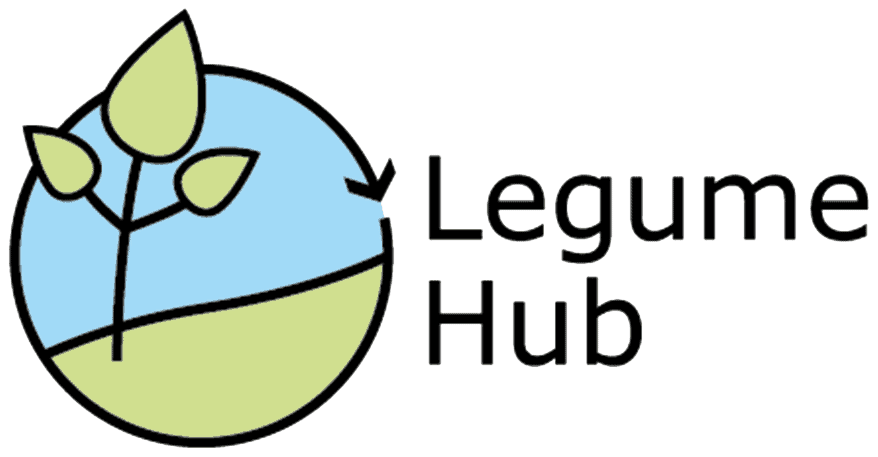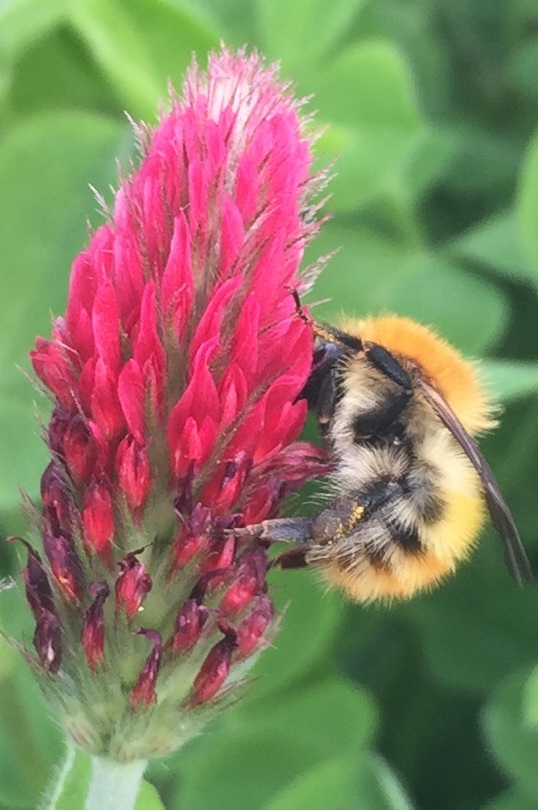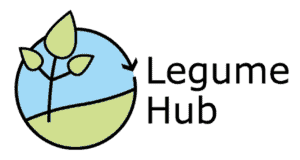Designing legume cropping systems for pollinators and production
Agriculture and pollinators
The countryside of Europe has undergone a radical transformation over the last 70 years. Traditional farming practices have given way to more intensive agriculture, with increased mechanisation of farm operations and use of agrochemicals. Hay meadows have been replaced by frequently cut silage fields, legume-rich pastures replaced by ryegrass swards, and small arable fields bounded by hedgerows replaced by extensive monocultures. While these changes have increased agricultural yield, they have adversely influenced farmland biodiversity including our pollinating insects.
Agricultural also, however, provides a vehicle to conserve pollinators through adopting more sustainable farming practices. The value of flower-rich field margins and hedgerows to insect pollinators is widely acknowledged. Less widely recognised is the fact that mass flowering crops such as field beans, and red clover can provide pulses of forage at critical points in the season complementing resources provided by agri-environment schemes. Such legumes provide a valuable source of sugar-rich nectar and protein-rich pollen, and the loss of legume-rich habitats is identified as a driver of pollinator declines [1].
Value of legumes to sustainable farming systems
Grain legumes (e.g. beans and peas) are rich in plant-based proteins and the EAT-Lancet Diet highlights the central role they could play in achieving food security. Additionally, fodder legumes (e.g. clover and alfalfa) provide an environmentally friendly alternative to imported soybean for livestock feed. Legumes are also unique in housing tiny bacteria, known as rhizobia, in their root nodules. These bacteria can fix atmospheric nitrogen, a form of nitrogen that is unavailable to plants, converting it to ammonia which plants can uptake. Through fixing nitrogen, legumes decrease the requirement for synthetic fertilisers, thus reducing the carbon footprint of the farm. In playing a critical role in enhancing the sustainability of our food production systems, legumes are likely to become more prevalent in future agricultural landscapes. Despite their potential, the management and implementation of legumes can restrict their value to pollinators [2].
Legume trial to determine optimum legume cropping systems
Legumes and pollinators are inherently linked. Legumes provide forage for pollinators, while insect pollination allows legumes to reproduce and maintain genetic diversity. This interdependence depends on both flower traits (e.g. flower size and shape, resources offered and the timing and duration of flowering) and insect traits (e.g. tongue length, activity period). A new study by SRUC aims to increase our understanding of how legumes and pollinators interact to identify legume cropping systems to benefit pollinators and production [3].
Legumes vary in the colour, size and shape of their flower, the quantity and quality of nectar and pollen produced, and the timing and duration of flowering. All these traits influence the pollinators that visit them. Legumes with small flowers and shorter corolla, such as alfalfa (Medicago sativa) and black medic (Medicago lupulina) are easily accessed by hoverflies with their short proboscises. The deep complex flowers of field beans, on the other hand, were most frequently visited legitimately by long-tongued garden bumblebees Bombus hortorum. I say legitimately, because shorter tongued bumblebees, such as the buff-tailed bumblebee, Bombus terrestris, were frequently observed nectar-robbing via tiny holes bitten at the flower base. These nectar-robbers steal the floral rewards without pollinating the plant!
Surprisingly, legume mixtures did not consistently perform better than monocultures. Clover mixtures (Trifolium spp.) attracted an abundance of pollinators. However, our beans (Vicia faba), vetch (Vicia sativa) and white clover mixture (Trifolium repens) was outperformed by monocultures such as crimson clover (Trifolium incarnatum) -with its dense flowers and rich floral rewards. Differences in the flowering period of legumes (known as flowering phenology), however highlighted the potential to combine early (e.g. Vicia faba), mid (e.g. T. incarnatum) and late (e.g. T. pratense) flowering species to provide forage more consistently through the season.
The ability of mixtures to support pollinators not only depends on resources, flower shape and timing of flowering, but also on how the species within the mixtures interact with each other – how they grow and thrive. We found that vetch and field beans were very competitive and quickly swamped lower lying species such as white clover (Trifolium repens). Consideration should therefore be given to the inclusion of highly competitive species within mixtures.
Legumes are only part of the solution
While we found high densities of pollinators foraging on resource-rich legumes, legumes don’t provide all the resources pollinating insects require. In Scotland, legumes didn’t start flowering till July, and with pollinating insects emerging in spring legumes should be complimented with habitats that provide early season forage (e.g. hedgerows, fruit trees). Furthermore, bumblebees need tussocky field margins to build their nests while many hoverfly larvae feed on decaying vegetation that is typically found along ditches, or woodland edges. A package of habitats, complementary in the resources they provide, is therefore required to support our pollinating insects and safeguard the pollination services that underpin food production.
1. Scheper, J., Reemer, M., van Kats, R., Ozinga, W.A., van der Linden, G.T., Schaminée, J.H., Siepel, H. and Kleijn, D., 2014. Museum specimens reveal loss of pollen host plants as key factor driving wild bee decline in The Netherlands. Proceedings of the National Academy of Sciences, 111(49), pp.17552-17557.
2. Cole, L.J., Kleijn, D., Dicks, L.V., Stout, J.C., Potts, S.G., Albrecht, M., Balzan, M.V., Bartomeus, I., Bebeli, P.J., Bevk, D. and Biesmeijer, J.C., 2020. A critical analysis of the potential for EU Common Agricultural Policy measures to support wild pollinators on farmland. Journal of Applied Ecology, 57(4), pp.681-694.
3. Cole, L.J., Baddeley, J.A., Robertson, D., Topp, C.F., Walker, R.L. and Watson, C.A., 2022. Supporting wild pollinators in agricultural landscapes through targeted legume mixtures. Agriculture, ecosystems & environment, 323, p.107648.
The countryside of Europe has undergone a radical transformation over the last 70 years. Traditional farming practices have given way to more intensive agriculture, with increased mechanisation of farm operations and use of agrochemicals. Hay meadows have been replaced by frequently cut silage fields, legume-rich pastures replaced by ryegrass swards, and small arable fields bounded by hedgerows replaced by extensive monocultures. While these changes have increased agricultural yield, they have adversely influenced farmland biodiversity including our pollinating insects.
Agricultural also, however, provides a vehicle to conserve pollinators through adopting more sustainable farming practices. The value of flower-rich field margins and hedgerows to insect pollinators is widely acknowledged. Less widely recognised is the fact that mass flowering crops such as field beans, and red clover can provide pulses of forage at critical points in the season complementing resources provided by agri-environment schemes. Such legumes provide a valuable source of sugar-rich nectar and protein-rich pollen, and the loss of legume-rich habitats is identified as a driver of pollinator declines [1].
Value of legumes to sustainable farming systems
Grain legumes (e.g. beans and peas) are rich in plant-based proteins and the EAT-Lancet Diet highlights the central role they could play in achieving food security. Additionally, fodder legumes (e.g. clover and alfalfa) provide an environmentally friendly alternative to imported soybean for livestock feed. Legumes are also unique in housing tiny bacteria, known as rhizobia, in their root nodules. These bacteria can fix atmospheric nitrogen, a form of nitrogen that is unavailable to plants, converting it to ammonia which plants can uptake. Through fixing nitrogen, legumes decrease the requirement for synthetic fertilisers, thus reducing the carbon footprint of the farm. In playing a critical role in enhancing the sustainability of our food production systems, legumes are likely to become more prevalent in future agricultural landscapes. Despite their potential, the management and implementation of legumes can restrict their value to pollinators [2].
Legume trial to determine optimum legume cropping systems
Legumes and pollinators are inherently linked. Legumes provide forage for pollinators, while insect pollination allows legumes to reproduce and maintain genetic diversity. This interdependence depends on both flower traits (e.g. flower size and shape, resources offered and the timing and duration of flowering) and insect traits (e.g. tongue length, activity period). A new study by SRUC aims to increase our understanding of how legumes and pollinators interact to identify legume cropping systems to benefit pollinators and production [3].
Legumes vary in the colour, size and shape of their flower, the quantity and quality of nectar and pollen produced, and the timing and duration of flowering. All these traits influence the pollinators that visit them. Legumes with small flowers and shorter corolla, such as alfalfa (Medicago sativa) and black medic (Medicago lupulina) are easily accessed by hoverflies with their short proboscises. The deep complex flowers of field beans, on the other hand, were most frequently visited legitimately by long-tongued garden bumblebees Bombus hortorum. I say legitimately, because shorter tongued bumblebees, such as the buff-tailed bumblebee, Bombus terrestris, were frequently observed nectar-robbing via tiny holes bitten at the flower base. These nectar-robbers steal the floral rewards without pollinating the plant!
Surprisingly, legume mixtures did not consistently perform better than monocultures. Clover mixtures (Trifolium spp.) attracted an abundance of pollinators. However, our beans (Vicia faba), vetch (Vicia sativa) and white clover mixture (Trifolium repens) was outperformed by monocultures such as crimson clover (Trifolium incarnatum) -with its dense flowers and rich floral rewards. Differences in the flowering period of legumes (known as flowering phenology), however highlighted the potential to combine early (e.g. Vicia faba), mid (e.g. T. incarnatum) and late (e.g. T. pratense) flowering species to provide forage more consistently through the season.
The ability of mixtures to support pollinators not only depends on resources, flower shape and timing of flowering, but also on how the species within the mixtures interact with each other – how they grow and thrive. We found that vetch and field beans were very competitive and quickly swamped lower lying species such as white clover (Trifolium repens). Consideration should therefore be given to the inclusion of highly competitive species within mixtures.
Legumes are only part of the solution
While we found high densities of pollinators foraging on resource-rich legumes, legumes don’t provide all the resources pollinating insects require. In Scotland, legumes didn’t start flowering till July, and with pollinating insects emerging in spring legumes should be complimented with habitats that provide early season forage (e.g. hedgerows, fruit trees). Furthermore, bumblebees need tussocky field margins to build their nests while many hoverfly larvae feed on decaying vegetation that is typically found along ditches, or woodland edges. A package of habitats, complementary in the resources they provide, is therefore required to support our pollinating insects and safeguard the pollination services that underpin food production.
1. Scheper, J., Reemer, M., van Kats, R., Ozinga, W.A., van der Linden, G.T., Schaminée, J.H., Siepel, H. and Kleijn, D., 2014. Museum specimens reveal loss of pollen host plants as key factor driving wild bee decline in The Netherlands. Proceedings of the National Academy of Sciences, 111(49), pp.17552-17557.
2. Cole, L.J., Kleijn, D., Dicks, L.V., Stout, J.C., Potts, S.G., Albrecht, M., Balzan, M.V., Bartomeus, I., Bebeli, P.J., Bevk, D. and Biesmeijer, J.C., 2020. A critical analysis of the potential for EU Common Agricultural Policy measures to support wild pollinators on farmland. Journal of Applied Ecology, 57(4), pp.681-694.
3. Cole, L.J., Baddeley, J.A., Robertson, D., Topp, C.F., Walker, R.L. and Watson, C.A., 2022. Supporting wild pollinators in agricultural landscapes through targeted legume mixtures. Agriculture, ecosystems & environment, 323, p.107648.



